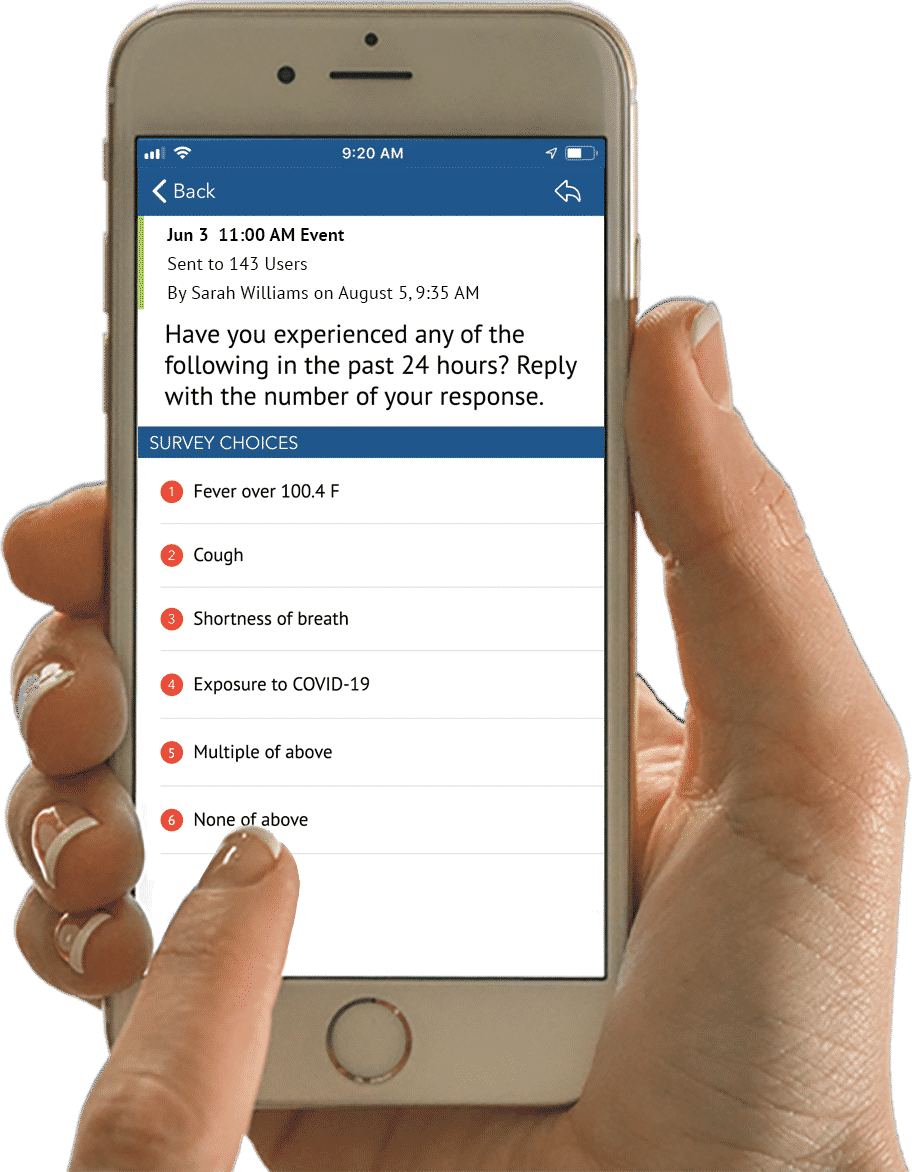
A Guide To Finding the Best Emergency Communication System
But not all emergency communication software is created equal. Here are five questions to ask when evaluating which system is best for your organization.

1. Why Do I Need An Emergency Communication System?
We all recognize that emergencies are happening more frequently than ever. Whether from natural disasters or workplace violence, the threats are real. Organizations are making great strides in preparing for all types of emergencies, yet the foundation of every emergency plan is an organization’s emergency communication system.
The right emergency communication system can help any organization reach all of its employees, near and far, with critical information and notifications instantly. It should not matter where employees are, how they work, or what device they are using. A good system will ensure everyone gets the messages they need, when they need them. Most companies employ a variety of workers. Some may be based in corporate offices, while others are on the road a majority of their work weeks. It is estimated that there are 488 million business trips taken annually in the U.S. and a 159% increase in remote work from 2005 to 2017. The truth is, many of us do not work full time in a corporate office where the environment can be a bit more controlled. We travel, work from home, have field jobs, or drive in a fleet. This dynamic and mobile workforce presents multiple challenges to organizations, including how to communicate during an emergency.

2. What Do Most Organizations Use?
In the past, most organizations relied on automated phone trees with a pre-recorded message, often providing a menu of options where they could be routed to additional information using their phone’s keypad or their voice. A big problem with phone trees is that many people do not answer their phones, particularly if they don’t recognize the number, because they are unavailable to talk. Since the average phone call is now under two minutes, many people simply do not feel like they have time to chat.
When email became mainstream, it was either used to complement phone trees or replaced them completely. Organizations could send emails of any length to employees, making it a much more versatile tool. But while email is effective in sending information and documents, it is considered painfully slow for emergency communications that require instant delivery. Even worse, emails have a disappointingly low open rate of less than 23 percent, partially because they get buried in the dozens, if not hundreds, of emails we receive each day.
An increasing number of organizations are now leveraging mass communication software that enables multi-channel distribution of messages. The software allows organizations to take advantage of all the communication channels its employees are most likely to use. Phone and email messages may be coupled with text notifications, app push notifications, social media posts, and custom channels. When notifications can be sent instantly and simultaneously across all of these channels, there is much less chance an employee will miss the alert.
3. What Do I Look For in A Communication System?
Emergency communication software differs greatly, and the ideal product will be customized to your organization’s specific needs and requirements. Some of the most common features of an emergency communication system will include:
- Instant communications
- Two-way communications
- Global intelligence
- Real-time communications
- Multi-channel communications
- Measurement tools with analytics and reporting
In any emergency, time is of the essence. Old information can be dangerous and cause confusion. The best software will allow an organization to communicate instantly to provide the latest updates without delay.
Two-way communication mirrors the expectations we now have to be a part of the conversation. Social media has changed our perceptions of how we should communicate, and now more than ever people appreciate being able to contribute and engage in dialogue. Modern mass communication systems put the spotlight on employee feedback and input. Oftentimes, first-hand eyewitnesses can often offer the most insight into a situation.
Today, multi-channel communication is vital, as employees are more mobile and dispersed than ever before. A communication system needs to enable more than just phone and email communications. It must include any and all channels your employees regularly use. Find a system that can send notifications and alerts simultaneously across all devices. Not only will this ensure the highest receive rate, but it will also get the employees’ attention as all channels are activated at once.
Event monitoring is a service some emergency communication vendors provide. When emergencies are impending or occurring, the organization will likely be in full-alert mode trying to communicate with its employees, authorities, and first responders while also initiating their business continuity plan. It can be a relief to know a third party is monitoring the situation and providing timely alerts and updates during the emergency. Look for a vendor who provides 24/7 monitoring so you can focus on the other critical tasks that need to take place during an emergency.
Measuring the success of an emergency system is an important step in any emergency plan. A solid communication system will give you the analytics you need to determine if your plan was effective—measuring how each delivery channel performed, open rates, response rates, and employee feedback. Using these metrics can help improve emergency plans, find gaps in message coverage, and identify areas for overall improvement.
Other features to consider when evaluating an emergency communication system are ease of use, implementation time, data security, customer support, costs, and cloud or on-premise options.
Ease of use
While communicating across channels in real time to every employee in your organization may sound complex, the software to enable such functionality shouldn’t be. In fact, the best software should be intuitive enough that it can be implemented and up-and-running in a matter of hours. No one has time for hours of training. Find a system that is comprehensive and provides the features listed above—but be sure it is easy to use right out of the box. The easier it is to use, the more likely it will be used.
Data security
Data security is always an issue. The software you choose must provide full encryption of your company’s data at rest and while in transit. In an emergency, the last thing you want to worry about is if your data is getting into the wrong hands. All messages need to be guaranteed they will only come from those designated to send them.
Support
Even though the system should be intuitive and easy to use, there are always times where you may need some help. These moments, unfortunately, often happen during an emergency when you don’t have time to spare. Ensure the vendor you choose provides around-the-clock support so you can get your message to the intended people rapidly. Service experts should also be able to assist you with any internal system integrations you may want to include with your implementation.
Cost
Cost is never far from mind, particularly when it comes to technology. Evaluate the cost structure of any product, whether it’s per seat, a license fee, or a flat rate. Be sure you only pay for what you know you’ll actually use. Consider which features are worth the investment, but always keep in mind that the safety of your employees and the ability for your organization to continue doing business after an emergency is worth the investment.
Cloud or premise
While some vendors might still have legacy, on-premise software, you will benefit from deploying a cloud-based solution. The benefits of cloud-based software are that there is no large upfront cost for the software as you typically pay a subscription fee. There are also no ongoing maintenance fees or special training you may need to maintain the software. One of the biggest advantages to a cloud-based option is that you don’t have to worry about the integrity of the software during a critical event, such as a fire or flood. The software resides off-premise so you can still access it, even during an emergency. For all these reasons, on-premise emergency communication systems are largely a thing of the past.
4. How Do I Implement A Communication System?
A communication system doesn’t end with the software selection. Sure, the software will bring functionalities you did not have before, but it can only be as effective as those who are empowered to use it. Your system of choice should be intuitive and easy-to-use. When you select a communication system that doesn’t require heavy training, you can easily add new administrators and those admins can send messages during critical events without pause or confusion. Knowing when and how to use the system, what is considered worthy of a notification, and who is to receive the communications takes planning, but you can soften those challenges by selecting the right partner.
The first step in implementing a communication system is to customize the software for your organization’s needs. Start by segmenting your population according to location. Every location will have its own list of employees, potential threats, and other considerations. A modern communication system will automate much of this for you, particularly if it is integrated with your HR application. Setting up the directories should not take long but can save you invaluable time when a critical situation arises.
You can further customize the software by adding specific channels you know are most prevalent in your organization. Does your company use two-way radios? App push notifications? Whatever channel you want to include should be able to be easily added and modified at will.
Use software that provides message templates for every channel, as well as the ability to customize your messages. If you know of certain situations when an automated notification can be sent, go ahead and create it. Otherwise, learn how to build your own message on the fly quickly, so you are familiar with the steps during an emergency event.

The second step is to evaluate potential threats. Conducting a business threat assessment will give you a better feel for potential dangers and what might trigger the need to use the system. Consider the fact that the most common emergencies are IT outages, weather-related incidents, power outages, natural disasters, and fires.
The final step is to practice using the system. Notify employees of the new system—and do so using the new system. Check to see if everyone received the notification, which channels delivered the notification, how long it took for the notification to be drafted and sent, and if the message sent was the right message.
It is a good idea to practice using the system in various scenarios, such as during a power outage where accessing email through desktop computers may not be possible. Similarly, during and after a tornado, cell coverage might be compromised and employees will rely on phone service.
Once a vendor is chosen, don’t be afraid to ask for help if you need it. The vendor should provide implementation and configuration support as part of the contract.
5. What Are Other Uses For An Emergency Communication System?
An emergency communication system isn’t just for emergencies. In fact, many organizations find the system is more of a mass communication system than strictly for emergencies. The system can be used in any situation where a group or large number of employees need information.
Some of the more interesting ways a communication system can be used have to do with logistics and scheduling. Generally, organizations with scheduled shift workers and/or fleet drivers have to manage a lot of moving parts. Using the system to communicate back and forth with these employees can be much more efficient than most dispatch systems.
Event planning, guest communications, and volunteer coordination are all eased with a mass communication system. Because the system can engage people across channels, organizations can send messages, alerts, notifications, and tips all more reliably. Emergency communication systems can be used to send:
- Weather-related notifications that may impact classes, events, or games
- Traffic alerts
- Members-only notifications
- Billing alerts
- Venue changes
- Event updates and reminders
- Closings or delays
- Logistics notifications
- Employee surveys
- Customer/employee satisfaction surveys

These are but a few of the possibilities a mass communication system offers. However you decide to use your emergency communication system, you can feel confident you will receive significant ROI from its scalability and usability across your organization.

